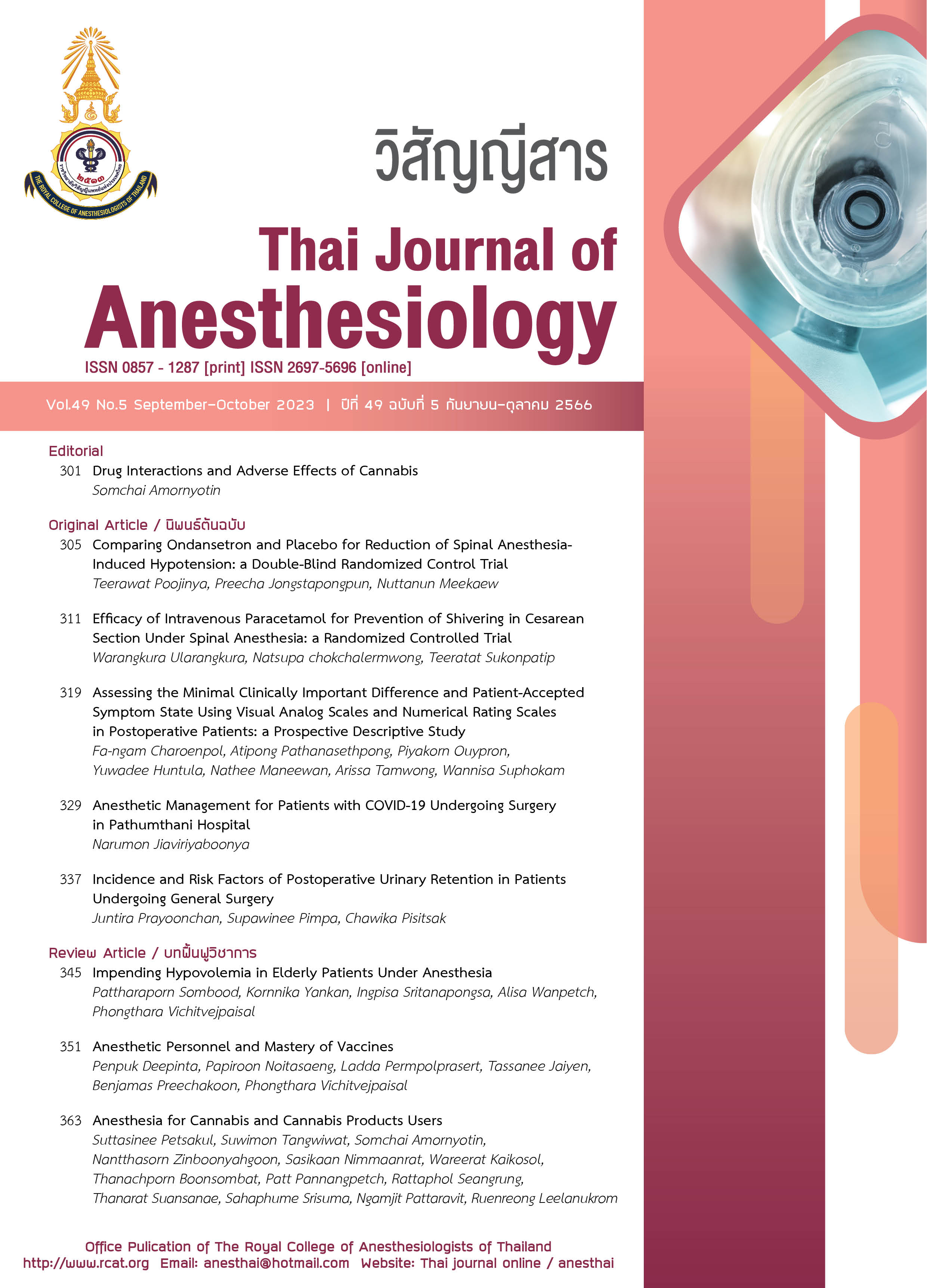Efficacy of Intravenous Paracetamol for Prevention of Shivering in Cesarean Section Under Spinal Anesthesia: a Randomized Controlled Trial
Main Article Content
Abstract
Introduction: Shivering is an important complication during and after caesarean section under spinal anesthesia cause discomfort to the parturient. Several pharmaceutical agents were used to reduce shivering. The aim of the study is to evaluate the efficacy of intravenous paracetamol for prevention of shivering in pregnancy during and after caesarean section under spinal anesthesia. Methods: A prospective randomized double-blind controlled clinical trial, 93 pregnant women, who scheduled for elective caesarean section under spinal anesthesia were randomly divided into two groups. One group received 100 ml of normal saline (group NS, n=46), and the other received 1000 mg of paracetamol intravenously (group P, n=47), after the delivery. The anesthetic technique was similar in both groups. Axillary temperature was measured before anesthesia, 30 min after anesthesia, end of the operation, immediately at PACU, every 30 min in PACU, and end of PACU. Intraoperative and postoperative shivering was graded on a scale of 0-4. Results: There were no significant differences in demographics, surgical characteristics and body temperature between the two groups. Shivering was observed in 2 patients (4.0%) in group NS and 3 patients (6.0%) in group P during surgery and was noted in 7 patients (15.0%) in group NS and 7 patients (15.0%) in group P at PACU. There was no significant shivering score between the two groups. There was no significant in the incidence of hypotension, nausea, and vomiting during surgery. Conclusion: Administration of intravenous paracetamol does not prevent the shivering in pregnant patients during and after cesarean section undergoing spinal anesthesia.
Article Details

This work is licensed under a Creative Commons Attribution-NonCommercial-NoDerivatives 4.0 International License.
References
Sessler DI. Temperature regulation and monitoring. In: Miller R, editor. Miller’s anesthesia. 8th ed. London: Churchill Livingstone: Elsevier. 2010;1622-46.
Sung HC, Lee BS, Yang HJ, et al. Effect of preoperative warming during cesarean section under spinal anesthesia. Korean J Anesthesiol. 2012;62:454-60.
Rasoli S, Ansari E, Moslemi F, Ghojazadeh M. The prophylactic administration of intravenous paracetamol for control of shivering during and after cesarean section under spinal anesthesia. Arch Anesthesiol Crit Care. 2019;5:38-40.
Oshvandi K, Shiri FH, Fazel MR, Safari M, Ravari A. The effect of pre-warmed intravenous fluids on prevention of intraoperative hypothermia in cesarean section. Iran J Nurs Midwifery Res. 2014;19:64-9.
Jain A, Gray M, Slisz S, Haymore J, Badjatia N, Kulstad E. Shivering treatments for targeted temperature management: a review. J Neurosci Nurs. 2018;50:63-7.
Lema GF, Gebremedhn EG, Gebregzi AH, Desta YT, Kassa AA. Efficacy of intravenous tramadol and lowdose ketamine in the prevention of post-spinal anesthesia shivering following cesarean section: a double-blinded, randomized control trial. Int J Womens Health. 2017;9:681-8.
Nallam SR, Cherukuru K, Sateesh G. Efficacy of intravenous ondansetron for prevention of postspinal shivering during lower segment cesarean section: a double-blinded randomized trial. Anesth Essays Res. 2017;11:508-13.
Sadegh A, Tazeh-Kand NF, Eslami B. Intrathecal fentanyl for prevention of shivering in spinal anesthesia in cesarean section. Med J Islam Republ Iran. 2012;26:85-9.
Kim YA, Kweon TD, Kim M, Lee HI, Lee YJ, Lee KY. Comparison of meperidine and nefopam for prevention of shivering during spinal anesthesia. Korean J Anesthesiol. 2013;64:229-33.
Kinjo T, Tadokoro T, Tokushige A, et al. Effects of perioperative administration of acetaminophen on postoperative shivering: a randomized, triple-blind, placebo-controlled trial. Anesth Analg. 2020;130:983-90.
Gholami A, Hadavi M. Prophylactic intravenous paracetamol for prevention of shivering after general anesthesia in elective cesarean section. J Obstet Anaesth Crit Care. 2016;6:81-5.
Crossley AW, Mahajan RP. The intensity of postoperative shivering is unrelated to axillary temperature. Anaesthesia. 1994;49:205-7.
Frank SM, Kluger MJ, Kunkel SL. Elevated thermostatic setpoint in postoperative patients. Anesthesiology. 2000;93:1426-31.
Fang J, Chen C, Cheng H, Wang R, Ma L. Effect of paracetamol (acetaminophen) on body temperature in acute stroke: a meta-analysis. Am J Emerg Med. 2017;35:1530-5.
Marin L, Höcker J, Esser A, Terhorst R, Sauerwald A, Schröder S. Forced-air warming and continuous core temperature monitoring with zero-heat-flux thermometry during cesarean section: a retrospective observational cohort study. Braz J Anesthesiol. 2022;72:484-92.
Butwick AJ, Lipman SS, Carvalho B. Intraoperative forced air-warming during cesarean delivery
under spinal anesthesia does not prevent maternal hypothermia. Anesth Analg. 2007;105:1413-9.
Cobb B, Cho Y, Hilton G, Ting V, Carvalho B. Active warming utilizing combined iv fluid and forced-air warming decreases hypothermia and improves maternal comfort during cesarean delivery: a randomized control trial. Anesth Analg. 2016;122:1490-7.


